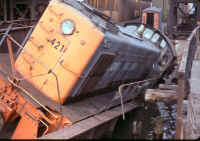As posted on the other forum:
Few things could have happened...
The suspension of the bridges is operated by a powered nut drive screw arrangement. If I had to guess ( merely a guess ) is the right one failed and busted off, thus the right side bridge goes crashing down, snaps the toggle bars and the weight of the engine causes the bridge to twist.
Its possible one of the threaded rods snapped from fatigue.
Its possible one of the counterweight cables snapped and caused a chain reaction.
If only the photos were zoomed out a little more..
Maybe JJ or one of our other former employees remember the details..
This type of bridge uses whats known as a contained apron ( aka the French type, after inventor James B. French). The bridge and the apron are one. The bridge is 110ft long, and the contained apron is 30, which is set inside the bridge. The contained apron allowed more movement, as well as the twisting. The contained portion was allowed to go with the flow. The bridge was hinged at land and the outer supported via the gantry. The drive nuts move the bridge up and down with counterweights taking up stress.
A pair of power winches were at either side used to haul the float in alignment and keep it tight. It might be possible ( but I doubt ) a line snapped causing the float to sway. This leading to the float backing out of the toggles ( toggles are chocked in ), in which the weight taken up by the toggles would cause the bridge to jump. I doubt this happened as the bridge operator would be taking up the tension on the toggles via the drive nuts in the gantry and in the time it takes for all this to happen im sure he would realize what was going on..but as I said..I think the only way to know is from somebody there..
Heres a page of mine going into more detail of the types of float bridges:
http://trainweb.org/AbandonedLIRR/bridges.htm
Paul

